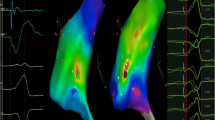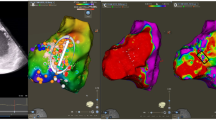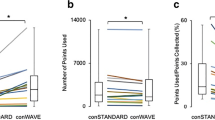Abstract
Background
The use of a multi-electrode Optrell mapping catheter during ventricular tachycardia (VT) or premature ventricular complex (PVC) ablation procedures has not been widely reported.
Objectives
We aim to describe the feasibility and safety of using the Optrell multipolar mapping catheter (MPMC) to guide catheter ablation of VT and PVCs.
Methods
We conducted a single-center, retrospective evaluation of patients who underwent VT or PVC ablation between June and November 2022 utilizing the MPMC.
Results
A total of 20 patients met the inclusion criteria (13 VT and 7 PVC ablations, 80% male, 61 ± 15 years). High-density mapping was performed in the VT procedures with median 2753 points [IQR 1471–17,024] collected in the endocardium and 12,830 points [IQR 2319–30,010] in the epicardium. Operators noted challenges in manipulation of the MPMC in trabeculated endocardial regions or near valve apparatus. Late potentials (LPs) were detected in 11 cases, 7 of which had evidence of isochronal crowding demonstrated during late annotation mapping. Two patients who also underwent entrainment mapping had critical circuitry confirmed in regions of isochronal crowding. In the PVC group, high-density voltage and activation mapping was performed with a median 1058 points [IQR 534–3582] collected in the endocardium.
Conclusions
This novel MPMC can be used safely and effectively to create high-density maps in LV endocardium or epicardium. Limitations of the catheter include a longer wait time for matrix formation prior to starting point collection and challenges in manipulation in certain regions.



Similar content being viewed by others
Abbreviations
- AAD:
-
Antiarrhythmic drug
- ECG:
-
Electrocardiography
- ICD:
-
Implantable cardioverter-defibrillator
- ILAM:
-
Isochronal late annotation mapping
- LPs:
-
Late potentials
- PVC:
-
Premature ventricular complex
- VA:
-
Ventricular arrhythmia
- VT:
-
Ventricular tachycardia
References
Tzou WS, Frankel DS, Hegeman T, et al. Core isolation of critical arrhythmia elements for treatment of multiple scar-based ventricular tachycardias. Circ Arrhythm Electrophysiol. 2015;8:353–61.
de Chillou C, Groben L, Magnin-Poull I, et al. Localizing the critical isthmus of postinfarct ventricular tachycardia: the value of pace-mapping during sinus rhythm. Heart Rhythm. 2014;11:175–81.
Parreira L, Marinheiro R, Carmo P, et al. Isolated diastolic potentials as predictors of success in ablation of right ventricular outflow tract idiopathic premature ventricular contractions. PLoS One. 2019;14: e0211232.
Aziz Z, Shatz D, Raiman M, et al. Targeted ablation of ventricular tachycardia guided by wavefront discontinuities during sinus rhythm: a new functional substrate mapping strategy. Circulation. 2019;140:1383–97.
Matto F, Venugopal D, Bhave PD, Rhodes TE, Mazur A. Utility of high resolution mapping to guide ablation of ventricular arrhythmias from the aortic sinuses of Valsalva. J Interv Card Electrophysiol. 2023;66:51–9.
Yavin HD, Bubar ZP, Higuchi K, Sroubek J, Yarnitsky J, Anter E. Propagation vectors facilitate differentiation between conduction block, slow conduction, and wavefront collision. Circ Arrhythm Electrophysiol. 2021;14: e010081.
Younis A, Yarnitsky J, Rodriguez H, Bubar ZP, Zilberman I, Anter E. Multipolar electrograms: a novel algorithm for accurate annotation of near-field potentials in scar. Heart Rhythm. 2022;19:S511.
Marchlinski FE, Callans DJ, Gottlieb CD, Zado E. Linear ablation lesions for control of unmappable ventricular tachycardia in patients with ischemic and nonischemic cardiomyopathy. Circulation. 2000;101:1288–96.
Hutchinson MD, Gerstenfeld EP, Desjardins B, et al. Endocardial unipolar voltage mapping to detect epicardial ventricular tachycardia substrate in patients with nonischemic left ventricular cardiomyopathy. Circ Arrhythm Electrophysiol. 2011;4:49–55.
Polin GM, Haqqani H, Tzou W, et al. Endocardial unipolar voltage mapping to identify epicardial substrate in arrhythmogenic right ventricular cardiomyopathy/dysplasia. Heart Rhythm. 2011;8:76–83.
Stevenson WG, Friedman PL, Sager PT, et al. Exploring postinfarction reentrant ventricular tachycardia with entrainment mapping. J Am Coll Cardiol. 1997;29:1180–9.
Irie T, Yu R, Bradfield JS, et al. Relationship between sinus rhythm late activation zones and critical sites for scar-related ventricular tachycardia: systematic analysis of isochronal late activation mapping. Circ Arrhythm Electrophysiol. 2015;8:390–9.
Viswanathan K, Mantziari L, Butcher C, et al. Evaluation of a novel high-resolution mapping system for catheter ablation of ventricular arrhythmias. Heart Rhythm. 2017;14:176–83.
Acosta J, Penela D, Andreu D, et al. Multielectrode vs. point-by-point mapping for ventricular tachycardia substrate ablation: a randomized study. Europace. 2018;20:512–9.
Di Biase L, Burkhardt JD, Lakkireddy D, et al. Ablation of stable VTs versus substrate ablation in ischemic cardiomyopathy: the VISTA randomized multicenter trial. J Am Coll Cardiol. 2015;66:2872–82.
Fernandez-Armenta J, Penela D, Acosta J, et al. Substrate modification or ventricular tachycardia induction, mapping, and ablation as the first step? A randomized study. Heart Rhythm. 2016;13:1589–95.
Proietti R, Dowd R, Gee LV, et al. Impact of a high-density grid catheter on long-term outcomes for structural heart disease ventricular tachycardia ablation. J Interv Card Electrophysiol. 2021;62:519–29.
Sousa PA, Antonio N, Barra S, Elvas L, Goncalves L. Pattern matching filter and multielectrode mapping catheter - a new approach for complex premature ventricular contraction ablation. Rev Port Cardiol (Engl Ed). 2021;40:423–31.
Martins RP, Benali K, Galand V, et al. Ablation of multifocal premature ventricular contractions using automated pace-mapping software. Rev Port Cardiol. 2022;41:653–62.
Funding
This work was supported by the Pennsylvania Steel Company EP Research Fund and the Winkelman Family Fund in Cardiovascular Innovation.
Author information
Authors and Affiliations
Corresponding author
Ethics declarations
Ethical approval
Retrospective use of data was approved by the IRB of the University of Pennsylvania.
Conflict of interest
DSF: lecture honoraria from and investigator for Biosense Webster. SN: consultant for CardioSolv, ImriCor, Dyne Pharmaceuticals, and Circle CVI; and principal investigator for research funding from Biosense Webster, ImriCor, and ADAS software. FM: consultant for Biosense Webster, Abbot Medical, and Medtronic; and has served as an investigator with research funding from Biosense Webster. TM: consultant for Biosense Webster. The remainder of the authors report nothing relevant to disclose.
Additional information
Publisher's note
Springer Nature remains neutral with regard to jurisdictional claims in published maps and institutional affiliations.
Rights and permissions
Springer Nature or its licensor (e.g. a society or other partner) holds exclusive rights to this article under a publishing agreement with the author(s) or other rightsholder(s); author self-archiving of the accepted manuscript version of this article is solely governed by the terms of such publishing agreement and applicable law.
About this article
Cite this article
Tan, J.L., Guandalini, G.S., Hyman, M.C. et al. Substrate and arrhythmia characterization using the multi-electrode Optrell mapping catheter for ventricular arrhythmia ablation—a single-center experience. J Interv Card Electrophysiol 67, 559–569 (2024). https://doi.org/10.1007/s10840-023-01618-5
Received:
Accepted:
Published:
Issue Date:
DOI: https://doi.org/10.1007/s10840-023-01618-5




